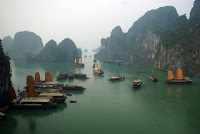I thought it would be nice to show pride in Jacobs country by learning more & sharing it. This is info I found on the internet..that I thought was interesting. Pics are from another blog I have been reading.It shows some typical & beautiful sites of Vietnam.. I will be added more pics from our trip soon.
The ancient origins of Vietnam's literature, language and culture, and the country itself, began in the north along the fringes of the Red River Delta. Long controlled and influenced by the Chinese, it enjoyed nine centuries of independence, until, in the 19th century, the French colonial period began. In 1887, Vietnam became a part of French Indochina.
At the end of World War II Vietnam declared its independence, however, France continued its control until soundly defeated by Ho Chi Minh's Communist forces in 1954. Shortly thereafter, based on the Geneva Accord, Vietnam was divided into two parts; the Communist North and the anti-Communist South. US economic and military aid to South Vietnam began to grow and serious conflict was on the horizon. In March, 1965, the first American troops landed in South VietnaAfter tens of thousands died on both sides, and billions in military expenditures, this sad, tragic war finally ended in 1973. Two years later the remains of the South's army fell, and Saigon, the capital of South Vietnam, was renamed Ho Chi Minh City, and North and South joined together as one. For the next few decades, Vietnam, demoralized by the affects of war, remained economically stagnant. Over the last five years Vietnam's government has made a series of changes (reforms) designed to make the country more competitive in the 21st Century, and by all accounts, it's working.
Tidbits
Name Vietnam (long form) Socialist Republic of Vietnam
Population 83,535,600
Capital City Hanoi (1.7 million)
Currency Dong (VND)
Languages Vietnamese (official), English, French, Chinese, Khmer, others
National Day September 2
Religions none (80%), Buddhist (9.3%), others
Latitude/Longitude (Capital City) 21º 01' N, 105º 52' E
Relative Location Vietnam is in both the eastern and northern hemispheres.It's positioned in Southeast Asia, a recognized geographical region of the Asian continent. The country is bordered by the Pacific Ocean, Gulf of Tonkin, Gulf of Thailand, South China Sea, and the countries of China, Laos and Cambodia.
Coastline 2,140 miles (3,444 km)
Land Areas (land) 125,622 sq miles (325,360 sq km)
(water) 1,621 sq miles (4,200 sq km)
Landforms Vietnam is a country of tropical lowlands, rolling green hills, and densely forested mountains. Low-level land covers about 20% of the country. The Red River delta is fronted by hills that rise gently into the high mountains of the northwest; the Annam Highlands cover much of the central landscape, and in the southern areas, the coastal lowlands and Mekong River Delta merge. A fertile and narrow coastal lowland extends south from the Red River Delta to the Mekong Delta. The Mekong Delta is a low-level plain, one inundated by hundreds of small rivers and canals. Thick jungles and mangrove swamps cover the far-southern areas of land. The Red River (Song Hong), and the Mekong are the most significant rivers; both have numerous tributaries, and the latter is certainly among the great rivers of the world.
Land Divisions 59 provinces and 5 municipalities; provinces include: An Giang, Bac Giang, Bac Kan, Bac Lieu, Bac Ninh, Ba Ria-Vung Tau, Ben Tre, Binh Dinh, Binh Duong, Binh Phuoc, Binh Thuan, Ca Mau, Cao Bang, Dac Lak, Dac Nong, Dien Bien, Dong Nai, Dong Thap, Gia Lai, Ha Giang, Hai Duong, Ha Nam, Ha Tay, Ha Tinh, Hau Giang, Hoa Binh, Hung Yen, Khanh Hoa, Kien Giang, Kon Tum, Lai Chau, Lam Dong, Lang Son, Lao Cai, Long An, Nam Dinh, Nghe An, Ninh Binh, Ninh Thuan, Phu Tho, Phu Yen, Quang Binh, Quang Nam, Quang Ngai, Quang Ninh, Quang Tri, Soc Trang, Son La, Tay Ninh, Thai Binh, Thai Nguyen, Thanh Hoa, Thua Thien-Hue, Tien Giang, Tra Vinh, Tuyen Quang, Vinh Long, Vinh Phuc and Yen Bai; municipalities include: Can Tho, Da Nang, Hai Phong, Hanoi and Ho Chi Minh
Travel Attractions
Attractions Vietnam is a visually stunning destination, one crammed with interesting things to see and do. Major points-of-interest include the cities of Hanoi and Ho Chi Minh (Saigon); Halong Bay, a UNESCO site featuring over 3,000 islands; PhongNha Cave, one of the largest and most beautiful caves on the planet; the mountain villages of Sapa and Dalat; hundreds of historical and cultural sites including the Hung Temple, Coloa citadel, the Temple of Literature in Hanoi, MySon Sanctuary, and the ancient city of HoiAn. Add to the brief list above the picturesque emerald-green rice paddy fields; boat trips through floating canal markets; Mekong Delta tours and sunset views atop Sam Mountain; thousands of inspiring pagodas and temples throughout the country, colorful festivals galore, and dozens of beautiful, clean beaches, north to south.
Climate
In general terms, Vietnam's climate is tropical; subject to monsoon rains, warm temperatures and wind, and high humidity throughout the year. The winter dry season extends (November - April), while summers (May - October) bring substantial rainfall across the entire country. Central and south, temperatures reach the mid 80s in the summer months, and in April, temps in the high 90s are commonplace; winter lows below 50° F are rare. In the northern third of the country, temperatures moderate, especially in the higher elevations.
for more info or to look up any other country you may desire to vacation to or just learn about.







0 comments:
Post a Comment